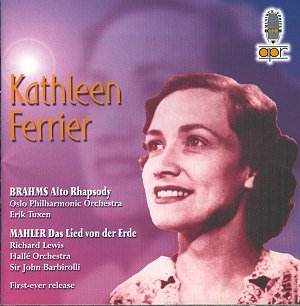This year marks fifty since the premature death from
cancer of the British lyric contralto Kathleen Ferrier. Her unique
voice never ceases to impact on the listener; it did so then and
still does now. She was a seminal figure; one of the first examples
of a ‘cross-over’ artist who entertained housewives, factory workers
and royalty in folk music, opera (limited), oratorio, lieder and
the vocal symphonies of Mahler (the latter thanks to Bruno Walter).
In this last respect Walter, and then Ferrier, prepared the way
for Klemperer to continue to establish that composer’s music in
Britain during the 1960s. This has led to Mahler’s huge popularity
today. Ferrier’s career lasted barely ten years from 1942 when she
emerged from her north-western roots where she was first a fine
pianist and then a serious singer from about 1938. As if guided
by a hand of destiny during those ten years, she was passed along
a chain-link fence within the music profession from one figure of
importance to another to progress her career. The list began with
her first teacher Dr Hutchinson, followed by Sargent (who advised
moving to London), agents Ibbs and Tillett, baritone Roy Henderson
(her next teacher), Pears, Britten, Glyndebourne, Festival directors
Rudolf Bing (Edinburgh) and Peter Diamand (Holland), Barbirolli
and Walter.
We still await the discovery of the buried treasure
of a recording of Ferrier singing the Angel in Elgar’s Dream
of Gerontius and conducted by Barbirolli. Meanwhile we have
the joys of these two new recordings, known about but not issued
until now, of familiar Ferrier fare. Scandinavia, like Holland,
appreciated Ferrier, and she toured there in 1949 including making
this recording of Brahms Alto Rhapsody (‘Alto Raspberry’
as she called it in her letters) for Norwegian Radio. She had
made a commercial recording for Decca in the expansive acoustics
of Kingsway Hall with the LPO under Clemens Krauss. This was a
disc she was particularly happy with and a work which sat so well
for her. Interestingly Tuxen’s is a swifter performance by three
minutes (than the one with Krauss) but not noticeably so for Ferrier,
who lingers and caresses her golden low register with comfortable
devotion.
The genesis of the recording of the Mahler is
quite extraordinary. On the night of the broadcast (Kathleen Ferrier’s
birthday, 22 April 1952) a young man called Gordon Rowley was
testing out his newly-acquired Ferrograph Mark I tape recorder
at his lodgings in Hertfordshire. In his own words he was literally
‘sticking a couple of wires in the back of my landlady’s antique
wireless set while she was out for the evening and hoping they
did not fall out again before the end. I also had to stop and
start between movements to cut the pauses or it would have overrun
the tape’. True the first seven bars were not recorded, the occasional
beat is missing in the sixth movement and some radio interference
intrudes at times in the last, but for all that this is a priceless
document for which we must offer grateful thanks to Mr Rowley
and to Bryan Crimp for his loving restoration. It is a truly remarkable
document. Its joys lie in the musical collaboration with Barbirolli
(she went on to make the famous Decca recording in Vienna with
Walter less than a month later) but not forgetting the vocal glories
of Richard Lewis in his prime. Barbirolli had conducted Das
Lied von der Erde in 1946 (though not with Ferrier) and did
not start to conduct any Mahler symphonies until a year after
she died in October 1953. However this dream team had given several
performances of the work just prior to making this broadcast.
That he adored the music is clear from the familiar groans and
grunts, as well as much string portamento in the Abschied.
There is also the remarkable playing of the Hallé, which
he had rebuilt during the war years (Janet Craxton is principal
oboe here, Oliver Bannister principal flute before he left Covent
Garden).
As for Ferrier, her diction is amazing with every
word coloured and imbued with emotion, the glorious voice utterly
free of the physical pain with which she was now having to cope.
Her fine performance with Walter may have justly earned its place
in recording history, and also because it is the last extant example
of her singing this work before death claimed her. However this
equally intense and moving account with Barbirolli has just as
much personal love and admiration between them: their shared love
of Mahler’s music, plus the glorious Lewis and the Hallé.
It is a recording for ‘ewig’. What more could one want? Oh yes,
that Dream of Gerontius of course.
Christopher Fifield
(‘Letters & Diaries of Kathleen Ferrier’
: to be published by Boydell & Brewer in October 2003)
|
Error processing SSI file
|
